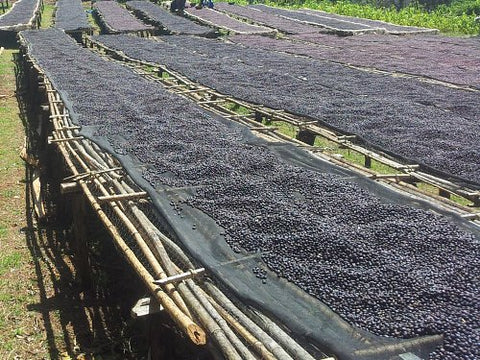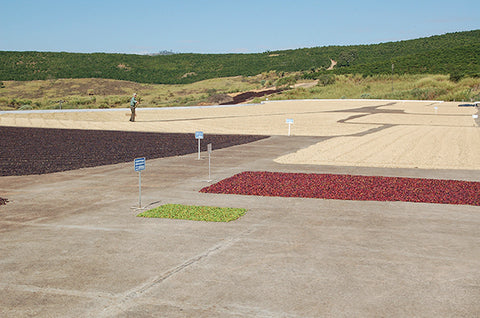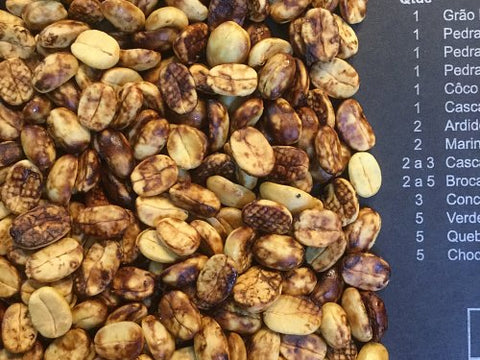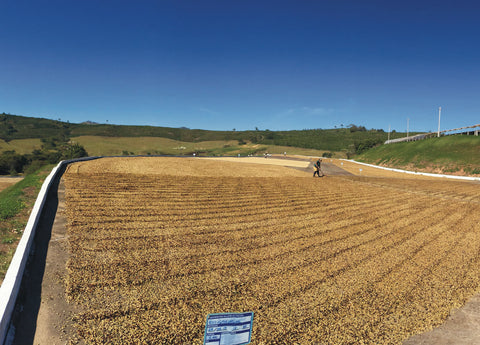Processing is what takes place from when the coffee cherries are harvested until the coffee beans are shipped as green beans to the roaster.
These methods lend varied attributes to your daily brew. You may find you have a preference for coffees processed a particular way.
There are three main methods in which coffees are processed.
Dry Processing (Natural)
This method is common in areas where large amounts of water are not readily available, and where long periods of warm, dry weather allows for beans to dry outdoors. This is the way coffee was traditionally processed before mechanisation.
Whole cherries are placed on drying beds, skin intact, to dry. Sugars on the fruit cause natural fermentation inside the cherry skin, to a point where the fruit becomes raisin-like and finally de-pulping can more easily occur. The cherry is harvested and placed on raised mats, beds, or patios to be dried in the sun.
Leaving the sweet skin on the bean for longer commonly results in a more complex, heavier and sweeter coffee with lower acidity. There are greater margins for error, however.
The drying process must be managed meticulously to gain the right amount of airflow around the beans and to protect them from humidity.
Over moistened beans are prone to both breaking down and harbouring bacteria and fungus – so this method is best for low rainfall regions.
In the past, the natural process was considered to be a lower-quality method, leading to inconsistent flavours.
However, nowadays many believe natural processed coffees –when processed correctly– can actually have the potential to be more flavourful, with interesting fruity notes and unique characteristics.
Typical Notes: Intense berry flavours, raisin, pineapple, white wine
Originated in: Ethiopia and Yemen

Natural drying cherries. Image Courtesy Cofi-com

Raised drying beds, Ethiopia. Image Courtesy Cofi-com
Wet processing (Washed Coffee)
In this process the outer cherry flesh is removed before drying, leaving the focus on the bean and its inherent qualities. Cherries are mechanically de-pulped, with only the mucilage layer left on the bean.
To remove this slimy mucilage, a natural fermentation process is used, whereby cherries are placed in large tanks of water for 8-50 hours. The soaking time varies between producer, equipment used and environmental factors such as climate.
Following the fermentation, beans are rinsed and drying takes place on concrete patios or raised beds.
The washed method leaves less room for error than natural processing. However, it is more expensive due to the machinery and large amounts of water required. For this reason, some coffee regions don’t have the ability to wet-process.
Wet-processed coffee results in a crisp, clean, more acidic cup and is the most common processing method today due to its consistent results.
Originated in: South America
Typical Notes: Chocolate, nuts, lemon, florals, stone fruit

Coffee drying, Brazil. Lighter coloured beans (rear of photo) are washed cherries. All fruit layers have been removed prior to drying. Image Courtesy Cofi-com

Semi-Washed (Honey Process)
With the delicious name of honey processed, one would expect a sweeter cup – and this is true for honey processed coffees, though it has nothing to do with honey! The honey name comes from the sweet sticky mucilage layer, reminiscent of honey.
Beginning in a similar way to washed coffee processing, the cherry flesh is removed and the mucilage layer left behind. This mucilage is left to dry on the bean, imparting that sweeter, fruitier flavour in the final cup.
Brazil is well known for this method, as it was one of the first countries to produce honey processed coffee. It is famous the world over for having some of the best honey processed coffees. This process may only be used in countries with low humidity, as the coffee must be quickly dried for optimum results. A coffee processed this way will have a lovely, bright sweetness to it created by the sugars being absorbed from the mucilage into the bean.
Typical Notes: Molasses, sugar cane, chocolate, cherry, strawberry
Originated in: Brazil and Costa Rica

Honey processed beans up close. Image Courtesy Cofi-com

There are so many variables during the processing stage that can affect the final cup.
Mistakes in the drying phase can lead to fermentation, mouldy flavours, and negatively affect the cup profile.
Green coffee beans can last up to a year – but if the drying phase was mishandled, you might find that the coffee tastes have faded and aged after just a couple of months.
All these things you may not consider when you grab a quick coffee-to-go in the morning! Have you noticed you prefer coffees from a particular processing origin?

